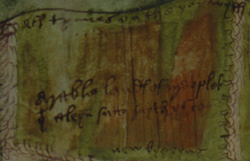 |
 |
 |
 |
 |
 |
 |
|
Arable and pastoral land (10/15) To sustain a self-sufficient community it was vital that the abbey acquired arable and pastoral land, or had rights to pasture its flocks and cattle in suitable areas. The Cistercians managed and exploited their lands by establishing granges. These were agricultural centres managed by the lay-brothers, from which the land was cultivated and harvested, and livestock reared. The establishment of Rievaulx’s granges was begun within twenty years of the abbey’s foundation, as indeed was the case with most of the other Northern houses.(27) The large grange at Griff was near to the abbey and was the home farm. Like most home granges Griff was never leased out but was directly exploited by the monks until the Dissolution, that is, it remained in demesne until that time when it was leased to the Earl of Rutland, who purchased the site. Most of Rievaulx’s granges were situated to the north and east of the abbey, where the land was well suited to arable and pastoral farming. The community had good arable lands at places such as Welburn, Hunmanby and Folkton; indeed, towards the end of Aelred’s abbacy, in the 1160s, Rievaulx purchased sixteen fields at Folkton. The Yorkshire Cistercians were renowned for their sheep farming. This was integral to the Cistercian economy, for sheep not only provided wool - which in turn could be either used to make clothing and blankets for the community, or sold - but were important for their milk and the manufacture of cheese. Furthermore, parchment and blankets could be made from sheep skins.(28)
Rievaulx acquired extensive pastoral lands to graze its large flocks but also created lush pastures by draining land in the Pickering Waste, which had been given to the community by Henry II (1154-89). Rievaulx’s pasture lands were scattered around Yorkshire.(29) The community had a number of sheep-houses (bercaries) where its flocks were folded. These included two sheep stations at Morton grange and the sheep house at Sproxton, which was associated with the grange at Griff. At Allerston, in Givendale Dyke, the abbey was granted permission to pasture five hundred sheep and to build sheep folds. The donor, however, reserved the right to dung from the fold. This might seem a rather strange request, but was by no means exceptional as dung was greatly valued as a fertiliser.(30) The actual size and structure of these sheephouses varied but, it seems, they might occupy an area of about an acre; the folds themselves were probably constructed from wood or brushwood hedges, but were sometimes built of stone and roofed with ferns.(31)
|

